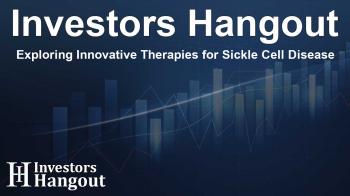Exploring Innovative Therapies for Sickle Cell Disease

Understanding Sickle Cell Disease and Innovative Treatments
Sickle Cell Disease (SCD) presents significant challenges for patients, marked by chronic hemolytic anemia and the painful episodes known as vaso-occlusive crises (VOCs). With traditional treatments often falling short, the landscape is evolving with innovative therapies. Key among these are pyruvate kinase (PK) activators that have sparked excitement in the medical community and offer a fresh approach to managing this complex condition.
Market Insights and Promising Developments
Recent insights indicate that the US sickle cell disease market is reaching a crucial transition point. Treating hematologists are encouraged by the emergence of gene therapies alongside new oral medications such as PK activators. However, despite optimism about these new tools, healthcare professionals recognize that barriers to access, adherence challenges, and the need for adequate patient support remain significant hurdles.
How PK Activators Work
PK activators, like mitapivat from Agios and etavopivat from Novo Nordisk, specifically target the energy metabolism of red blood cells. By enhancing ATP production and lowering 2,3-DPG levels, these therapies are believed to improve the resilience of red blood cells, ultimately increasing their lifespan and oxygen-carrying capacity. This represents a shift in treatment paradigms, providing a path that can complement existing disease-modifying therapies.
Potential Patient Benefits
Physicians express promising sentiments towards PK activators for their ability to address various clinical issues simultaneously. They estimate that approximately 40% of SCD patients might be suitable candidates for this innovative treatment, impacting both transfusion-dependent and non-transfusion-dependent individuals. The oral administration of these agents along with their favorable safety profiles enhances their desirability among healthcare providers.
Clinical Considerations and Future Directions
While the enthusiasm for PK activators is palpable, long-term studies are crucial for understanding their sustained efficacy. Physicians emphasize that establishing the safety and effectiveness of these treatments in the long run is vital, particularly in achieving meaningful improvements in hemoglobin levels and reducing VOC occurrences. If approved, it’s anticipated that PK activators could play a role not only as standalone therapies but also as part of combination treatment regimens or interim solutions while patients await curative therapies like gene therapy.
Broader Implications for Sickle Cell Disease Treatment
The growing focus on PK activation underscores a broader evolution in SCD management. The medical community actively seeks therapies that can be seamlessly integrated into everyday patient care, minimizing the associated burdens while maximizing therapeutic outcomes. As the treatment landscape diversifies, patients may soon benefit from a more comprehensive approach that tackles the complex nature of sickle cell disease from multiple angles.
The Role of Market Intelligence
Market Dynamix™ serves as a pivotal resource that understands the changing dynamics within this specialty market. This independent service utilizes both quantitative and qualitative research to shed light on current treatment methodologies, unmet patient needs, and the implications of emerging therapies. Through its insights, stakeholders gain a well-rounded perspective essential for navigating this rapidly evolving field.
Frequently Asked Questions
What is Sickle Cell Disease?
Sickle Cell Disease is a genetic blood disorder characterized by the development of abnormal hemoglobin, leading to distorted red blood cells that can cause blockages in blood flow and pain.
What are pyruvate kinase activators?
Pyruvate kinase activators are a class of medications aimed at improving red blood cell energy metabolism, potentially enhancing their lifespan and functionality in patients with Sickle Cell Disease.
How do PK activators improve patient outcomes?
PK activators work by boosting ATP production in red blood cells and lowering specific levels that contribute to the disease, improving oxygen delivery and reducing complications over time.
Are PK activators safe for all SCD patients?
While many patients may benefit from PK activators, healthcare providers will evaluate individual health profiles to determine safety and suitability for this treatment.
What is the future of Sickle Cell Disease treatments?
The future involves improved therapies like PK activators, ongoing research, and potential integration of these new drugs into combination therapies, enhancing care for Sickle Cell Disease patients worldwide.
About The Author
Contact Henry Turner privately here. Or send an email with ATTN: Henry Turner as the subject to contact@investorshangout.com.
About Investors Hangout
Investors Hangout is a leading online stock forum for financial discussion and learning, offering a wide range of free tools and resources. It draws in traders of all levels, who exchange market knowledge, investigate trading tactics, and keep an eye on industry developments in real time. Featuring financial articles, stock message boards, quotes, charts, company profiles, and live news updates. Through cooperative learning and a wealth of informational resources, it helps users from novices creating their first portfolios to experts honing their techniques. Join Investors Hangout today: https://investorshangout.com/
The content of this article is based on factual, publicly available information and does not represent legal, financial, or investment advice. Investors Hangout does not offer financial advice, and the author is not a licensed financial advisor. Consult a qualified advisor before making any financial or investment decisions based on this article. This article should not be considered advice to purchase, sell, or hold any securities or other investments. If any of the material provided here is inaccurate, please contact us for corrections.

